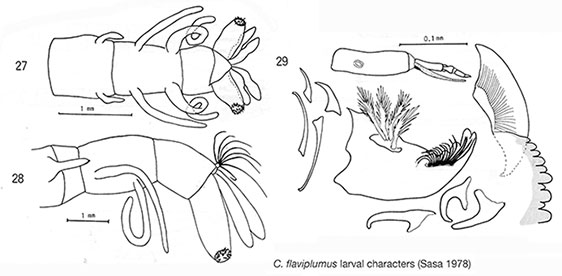C. flaviplumus sensu Sasa (Type A)This variant was described by Sasa (1978). This is more likely to be C. flaviplumus sensu Tokunaga as it was collected in northern Japan and has the higher AR. Sasa lists important features as the AR of 3.5-4.0; LR of about 1.6-1.8 and the relatively long anterior Ta5, which is about 0.35-0.4 length of anterior Ti. Adult: Color: Antenna with yellow hairs; thorax pale yellow to yellowish green, scutellum yellow, vittae and post notum orange yellow. Leg segments largely yellow brown, some darkening at distal ends of tibiae annd tardii, with Ta5 almost entirely dark. Head: Frontal tubercles about 33-39 µm. Palp proportions: 44 : 53 : 189 : 222 : 315; P5/P4 1.42, P5/P3 1.65. Thoracic setae not recorded Wing length: 2.85-3.15 mm; wing width 0.30-0.67 mm., VR about 1.0. Wing milky white with crossvein dark. Leg lengths (microns) and proportions as follows:
Superior volsella "beaked" closest to Fig. a of Strenzke (1959). Inferior volsella (IVo) not reaching the end of the anal point, but to about the midpoint of the gonostyle, which is only moderately swollen and reduces relatively sharply from about half way. Setae of IVo branched. Female
Abdomen largely brown, except for a pale area posterior on segments II-VI; II and III with a broader band, with an extension of the brown area in the midline. No information on segment X or the cercus. Pupa: Exuvia length about 7.8 mm (female), 7.0-7.5 mm (male). Caudolateral spur of segment VIII commonly with 3 spines, but range from 1-4 (Sasa 1978), often with one longer, stronger spine, see Fig. 26.  Fourth instar larva: a medium sized plumosus-type larva (length about 14.0-14.8 mm.). Anterior ventral tubules (1.14-1.20 mm.) shorter than posterior pair (1.40-1.52 mm.). Anal tubules long and cylindrical, about 250-320 µm, about 2.3-3.2 times longer than wide, ventral pair possibly slightly shorter and thicker (260 x 100; 250 x 110 µm). Gula pale or very slightly darkened on posterior third; frontoclypeus pale. Cytology (based on material studied by Wuëlker et al. 1989 and unpublished): 4 polytene chromosomes with the pseudothummi arm combination AE, BF, CD, G. Nucleolus virtually terminal in arm G; well developed BR about one third from the other end, and a smaller BR close to this other end; closely paired. A nucleolus also occurs near the characteristic bands of arm F. Arm A of Australian C. "orientalis" differs from that of this species by a complex inversion, and arm F by possibly a simple inversion. flaB1: Puff with distal dark bands (groups 8-7?) about the middle of the arm flaC1: Characteristic band groups 3-4 about one quarter from distal end. flaC2: Differs by a small terminal inversion, distal of characteristic band groups 3-4. flaD1: flaE1: 1 - 3e, 10b - 3f, 10c - 13 as halophilis, etc. flaF1: 1 -2a, 10d-a, 15 - 11, 2b - 9, 16 - 23 flaG1: Virtually terminal nucleolus, two BRs as noted above. flaG2: Simple inversion of most of the chromosome, bringing the large BR close to the nucleolus. Chromosome arms A, E and F were described by Wülker et al. (1989) as C. samoensis. However, some sequences of Australian specimens are not the same, although closely related. Important features are the central oval spots on abdominal tergites II-IV, the LR of about 1.8-2.0 (though known range of the possibly multiple species: 1.6-1.8) and the relatively long anterior Ta5, which is about 0.35-0.4 length of anterior Ti. Found: JAPAN - NEIS and Hanamuro, Tsukuba; Minitoku, Tokyo; Ohta River, Hiroshima Prefecture; The Creek, Minamidaito Island, Okinawa (abt.25°N, 131°E)(Sasa & Suzuki 2001); Ryukyu: Mt Omotodake, Ishigaki City, Ishigaki Island, Yaeyama Islands, Okinawa Prefecture. Molecular Sequence:MtCOI: Sequence for these specimens is in GenBank (accession numbers AB740235-9), the BOLD Database and the Japanese Chironomid Barcode Database - often identified as C. flaviplumus, but as noted above, the identity of the true C. flaviplumus has yet to be confirmed. |
Modified: 9 July 2025
Access: Unrestricted
Copyright © 2009-2025, Jon Martin.